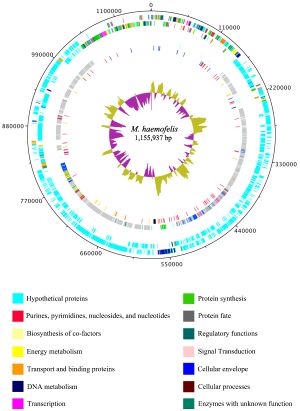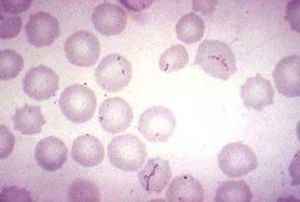Haemobartonella felis: Difference between revisions
Maggiebenson (talk | contribs) |
Maggiebenson (talk | contribs) |
||
| Line 34: | Line 34: | ||
What kind of interaction do host and symbiont have? How is the host affected by the relationship? How does the host acquire and transmit the symbiont? Is the interaction obligate or facultative? | What kind of interaction do host and symbiont have? How is the host affected by the relationship? How does the host acquire and transmit the symbiont? Is the interaction obligate or facultative? | ||
The interaction of the host, a feline, and the symbiont, ''Mycoplasma haemofelis'' is one of a parasitic relationship. | The interaction of the host, a feline, and the symbiont, ''Mycoplasma haemofelis'' is one of a parasitic relationship. If the host acquires a relationship with the symbiont, the host will become anemic, which affects the host red blood cell count. It is unclear of how the symbiont and disease is transmitted. However, some studies suggest that it is transmitted by fleas. | ||
Since transmission is unclear, treatments are possible but not known to completely treat anemia for the infected feline. The most commonly used treatment is doxycycline that can be used for 14-21 days with one dosage a day (7). | |||
==Molecular Insights into the Symbiosis== | ==Molecular Insights into the Symbiosis== | ||
Revision as of 20:49, 25 November 2011
Wiki in progress
Characteristics of the symbiont/pathogen
The name of the microbe Haemobartonella felis has been recently renamed to Mycoplasma haemofelis due to a closer relation to the genus Mycoplasma rather than the genus Bartonella (9). The genome of Mycoplasma haemofelis has been completely sequenced, and in fact it is the first hemotrophic mycoplasma species that has been completely sequenced. In a study that compared two strains of the microbe, Ohio2 and Langford 1, they found that the complete genome of the circular chromosome was of the size 1,155,937 base pairs (5). Figure 1 from the previous study shows the large genome of Mycoplasma haemofelis and that contains a large amount of unique proteins.
The phylogenetic classification of Mycoplasma haemofelis is(4):
- Domain: Bacteria
- Phylum: Tenericutes
- Class: Mollicutes
- Family: Mycoplasmataceae
- Genus: Mycoplasma
- Species: Haemofelis
The cell morphology of Haemobartonella felis, or Mycoplasma haemofelis, is a short coccus- or rod-shaped , gram negative bacteria. It also lacks a cell wall. The microbe is unable to be cultured, so a microscopic identification from a blood smear is needed for diagnosis (3).


Characteristics of the host
What host/s is/are involved? Is there host specificity? Are there secondary reservoirs?
The host for Mycoplasma haemofelis is a feline. It is unclear of what breeds of felines are most commonly effected. However, it is found that felines of older non-pedigree are more at risk for the infection that Mycoplasma haemofelis even though younger felines can be affected (7). In other studies, they found that the infection is more common in felines from regions like Switzerland and other European countries (10).
Host-Symbiont Interaction
What kind of interaction do host and symbiont have? How is the host affected by the relationship? How does the host acquire and transmit the symbiont? Is the interaction obligate or facultative?
The interaction of the host, a feline, and the symbiont, Mycoplasma haemofelis is one of a parasitic relationship. If the host acquires a relationship with the symbiont, the host will become anemic, which affects the host red blood cell count. It is unclear of how the symbiont and disease is transmitted. However, some studies suggest that it is transmitted by fleas.
Since transmission is unclear, treatments are possible but not known to completely treat anemia for the infected feline. The most commonly used treatment is doxycycline that can be used for 14-21 days with one dosage a day (7).
Molecular Insights into the Symbiosis
Describe molecular/genetic studies on the symbiosis.
Ecological and Evolutionary Aspects
What is the evolutionary history of the interaction? Do particular environmental factors play a role in regulating the symbiosis?
Recent Discoveries
Describe two findings on the symbiosis published within the last two years.
References
1. [[3]Barker, E.N. et al. (2011). Complete genome sequence of Mycoplasma haemofelis, a Hemotropic Mycoplasma. J. Bacteriol, 193.8, 2060-2061. ]
2. [[4] Berent, L.M., and Messick, J.B. (2003). Physical map and genome sequencing survey of Mycoplasma haemofeli (Haemobartonella felis). American Society of Microbiology, 71.6, 3657-3662.]
3. [[5] Messick, J.B., Berent, L.M., and Cooper, S.K. (1998).Development and evaluation of PCR-Based assay for detection of Haemobartonella felis in cats and differentiation of H. felis from related bacteria by restriction fragment length polymorphism analysis. Journal of Clinical Microbiology, 36.2, 462-466.]
4. [[6] Genome information for Mycoplasma haemofelis. NCBI Website. ]
5. [[7] Santos et al. (2011). Genome of Mycoplasma haemofelis, unraveling its strategies for survival and persistence . Veterinary Research, 42.102, 1-16. ]
6. [[8] Tasker, S. et al. (2009). Description of outcomes of experimental infection with feline haemoplasmas: Copy numbers, haematology, Coomb’s testing and blood glucose concentrations. Vet. Microbiol., 139.3-4, 323-332. ]
7. [[9] Tasker, S. and Lappin, MR. (2002). Haemobartonella felis: recent developments in diagnosis and treatment. Journal of Feline Medicine and Surgery, 4, 3-11.]
8. [[10] Tasker, S. (2010). Haemotropic mycoplasmas: What’s their real significance in cats? J Feline Med Surg., 12.5, 369-381. ]
9. [11] Willi, B. et al. (2007). From Haemobartonella to hemoplasma: Molecular methods provide new insights. Vet. Microbiology, 125.3-4, 197-209.]
10. [12] Willi, B. et al. (2010). Haemotrophic mycoplasmas of cats and dogs: transmission, diagnosis, prevalence and importance in Europe. Schweiz Arch Tierheilkd, 152.5, 237-44.]
Edited by Maggie Benson, students of Grace Lim-Fong
This template is just a general guideline of how to design your site. You are not restricted to this format, so feel free to make changes to the headings and subheadings and to add or remove sections as appropriate.
